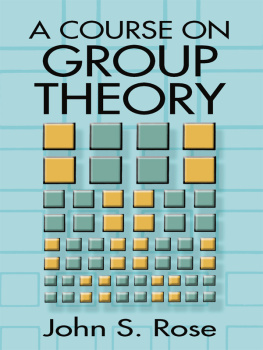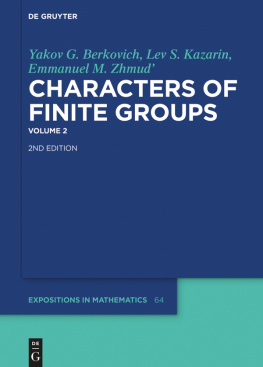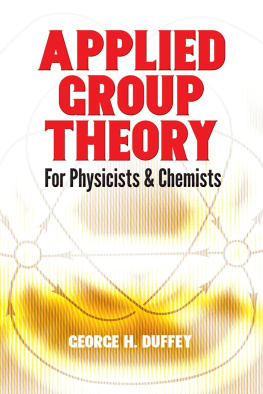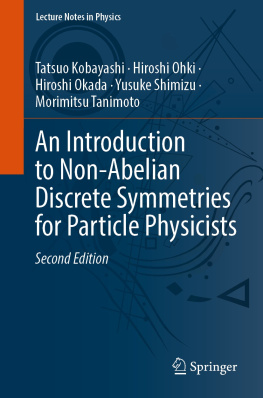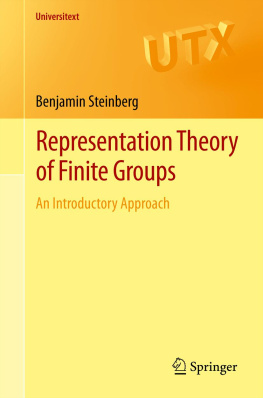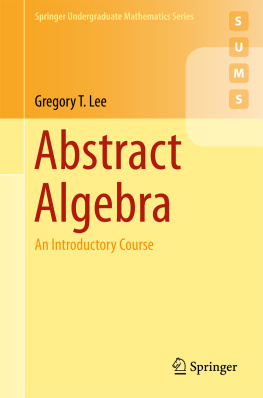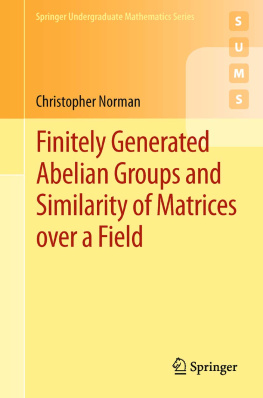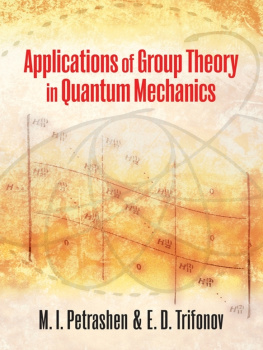Copyright
Copyright 1978, by Cambridge University Press.
All rights reserved.
Bibliographical Note
This Dover edition, first published in 1994, and reissued in 2012, is an unabridged and unaltered republication of the work first published by the Cambridge University Press, Cambridge, England, in 1978.
Library of Congress Cataloging-in-Publication Data
Rose, John S.
A course on group theory / John S. Rose. 1st Dover ed.
p. cm.
Originally published: Cambridge : Cambridge University Press, 1978.
Includes bibliographical references and index.
ISBN-13: 978-0-486-68194-8
ISBN-10: 0-486-68194-7
1. Group theory I. Title.
QA174.2.R66 1994
512.2dc20
94-20435
CIP
Manufactured in the United States by Courier Corporation
68194703
www.doverpublications.com
CONTENTS
In his presidential address to the London Mathematical Society in 1908 (published in the article [a12]), William Burnside remarked that It is undoubtedly the fact that the theory of groups of finite order has failed, so far, to arouse the interest of any but a very small number of English mathematicians And he ended with the words I wish, in conclusion, to appeal to those who have the teaching of our younger pure mathematicians to do something to stimulate the study of group-theory in this country. If, when advice is given for the course of study to be pursued, the importance of some knowledge of group-theory for a pure mathematician (which is generally recognized elsewhere) were insisted on, there is little doubt but that a demand for the serious teaching of the subject would soon arise.
Seventy years on, such a plea would be scarcely necessary: the central importance of group theory is now fully recognized and reflected in the teaching of mathematics in universities and colleges. No doubt this is due in no small measure to the profound influence of Burnsides own masterly book on the subject of groups ([b3]). Nowadays it is customary in British universities to provide introductory courses of lectures on groups and other algebraic systems for undergraduates in their first year of study. The present work offers material for a further course of study on group theory. It is based on courses of lectures given by the author at the University of Newcastle upon Tyne to third year honours undergraduates and to candidates for the Masters degree.
The reader is supposed to be familiar with the contents of the kind of introductory course mentioned above. Specifically, knowledge is presupposed of the notions of isomorphism classes of groups, cyclic and abelian groups, subgroups and cosets, Lagranges theorem, orders of elements, symmetric groups and the decomposition of a permutation as a product of disjoint cycles; and of the most elementary properties of vector spaces, linear maps and matrices, fields and rings. A rather terse summary of the facts about groups which are presupposed is contained in the preliminary , which also serves to establish notation used throughout the book.
.
The systematic treatment begins in treat aspects of the interplay between normal and arithmetical structures.
A particular emphasis is placed on the idea of group actions. This is conceptually important as typifying the way in which groups occur in mathematics, as well as providing a powerful method within group theory itself. The basic facts about group actions are given in .
calls for special comment. It is devoted to an exposition of the beautiful treatment of the classical notions of transfer and splitting by means of group action arguments which was given by Professor Helmut Wielandt in a lecture at the Mathematisches Forschungsinstitut, Oberwolfach, in May 1972. This provides a very impressive illustration of the power of group action techniques within group theory. This material has not previously appeared in print and I am very greatly indebted to Professor Wielandt for allowing me to include it here.
Any book which attempts to give a general account of group theory must inevitably be selective. To the practitioner of the subject who inspects the book, the omissions are probably more striking than the topics chosen for inclusion. In offering the present work for scrutiny, I am especially conscious of two major omissions: the representation theory of finite groups (and the associated theory of group characters) and the theory of defining relations of groups. Of these two important topics, the first may seem a surprising omission from a book which stresses group actions, since representation theory may be viewed as the theory of group actions on vector spaces (as is explained at the beginning of . On the subject of defining relations, I wish also to mention explicitly the important established work of reference by H. S. M. Coxeter and W. O. J. Moser [b6], and the recent book by D. L. Johnson [b22].
The present work is arranged in short sections which are numbered consecutively through each chapter. In many instances, a section is devoted to the statement and proof of a single result, to which reference may be made in other parts of the book by citing the appropriate section number. The more important results are designated Lemma or Theorem.
The exercises form an essential constituent of the book. They are numbered consecutively from to , their numbers appearing in bold type. Exercises to appear at the end of onward, the exercises are set at roughly equal intervals throughout the text. The aim is to give exercises which illustrate and extend the material of the formal course as soon as the relevant facts have been established in the text. There are many cross-references to exercises, particularly in the later chapters of the book: these references are given merely by citing exercise numbers; it is hoped that the regular distribution of the exercises and the bold type of their numbers will make these easy to locate without the additional citation of page numbers. The statements of many of the exercises omit the conventional imperatives prove that or show that; they are nevertheless assertions to be proved. I imagine that few readers of the book are likely to attempt all the exercises. However, a number of definitions and results given in exercises are needed in the main text, and these are indicated by asterisks against their numbers (e.g. *1 ); these exercises are mostly straightforward. Many of the more difficult exercises are accompanied by suggested hints for their solution.
Dates have been attached to some results in order to indicate a historical perspective to the development of the subject. For the same reason, various references to early articles and books have been included in the list at the end of the book. However, no pretence of historical scholarship is made: this is a book on group theory, not on the history of the subject. For a scholarly account of the early development of group theory, the reader may consult the book by H. Wussing [b40].
The references to works of other authors are divided into articles, with numbers prefixed by the letter a, and books, with numbers prefixed by the letter b. The works listed are mainly those to which reference is made in the text and in no way constitute a comprehensive bibliography of the subject. Many of the authors quoted have written other important works on group theory, and there are of course also many important works by authors who are not quoted. An impression of the scope and bulk of publication on group theory in the years 1940 to 1970 may be obtained from the recently published volumes of reviews taken from the periodical Mathematical Reviews: Reviews on Finite Groups (ed. D. Gorenstein, Amer. Math. Soc. 1974) and Reviews on Infinite Groups (2 vols., ed. G. Baumslag, Amer. Math. Soc. 1974).

